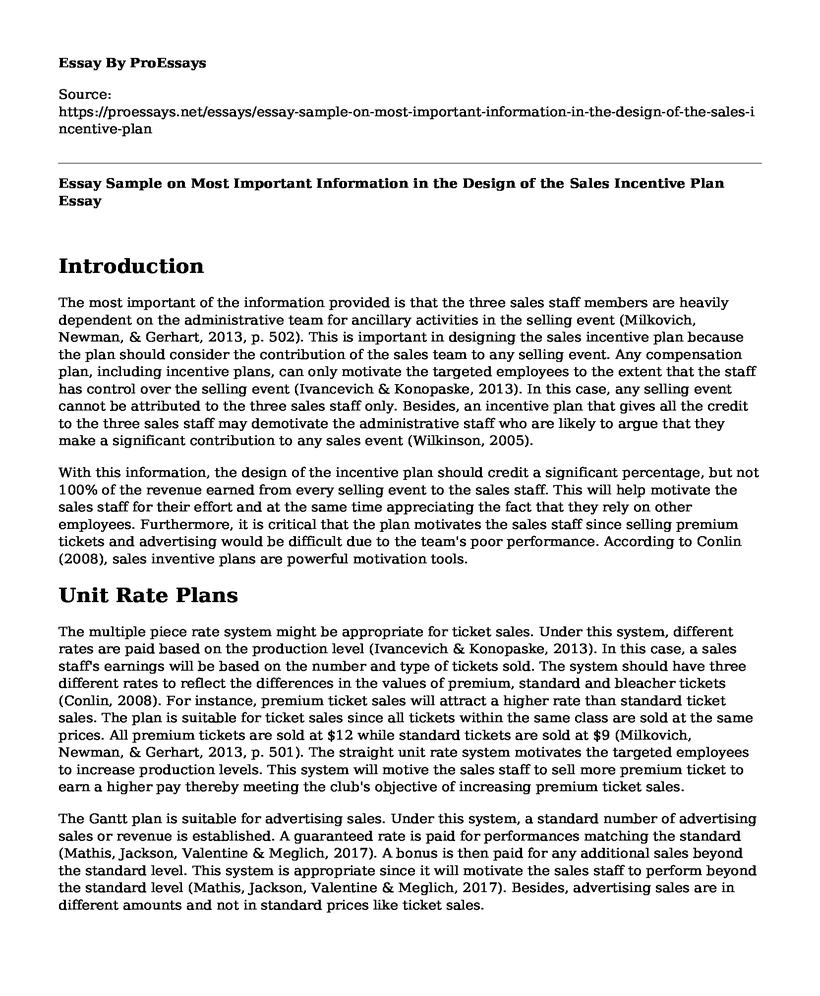Introduction
The most important of the information provided is that the three sales staff members are heavily dependent on the administrative team for ancillary activities in the selling event (Milkovich, Newman, & Gerhart, 2013, p. 502). This is important in designing the sales incentive plan because the plan should consider the contribution of the sales team to any selling event. Any compensation plan, including incentive plans, can only motivate the targeted employees to the extent that the staff has control over the selling event (Ivancevich & Konopaske, 2013). In this case, any selling event cannot be attributed to the three sales staff only. Besides, an incentive plan that gives all the credit to the three sales staff may demotivate the administrative staff who are likely to argue that they make a significant contribution to any sales event (Wilkinson, 2005).
With this information, the design of the incentive plan should credit a significant percentage, but not 100% of the revenue earned from every selling event to the sales staff. This will help motivate the sales staff for their effort and at the same time appreciating the fact that they rely on other employees. Furthermore, it is critical that the plan motivates the sales staff since selling premium tickets and advertising would be difficult due to the team's poor performance. According to Conlin (2008), sales inventive plans are powerful motivation tools.
Unit Rate Plans
The multiple piece rate system might be appropriate for ticket sales. Under this system, different rates are paid based on the production level (Ivancevich & Konopaske, 2013). In this case, a sales staff's earnings will be based on the number and type of tickets sold. The system should have three different rates to reflect the differences in the values of premium, standard and bleacher tickets (Conlin, 2008). For instance, premium ticket sales will attract a higher rate than standard ticket sales. The plan is suitable for ticket sales since all tickets within the same class are sold at the same prices. All premium tickets are sold at $12 while standard tickets are sold at $9 (Milkovich, Newman, & Gerhart, 2013, p. 501). The straight unit rate system motivates the targeted employees to increase production levels. This system will motive the sales staff to sell more premium ticket to earn a higher pay thereby meeting the club's objective of increasing premium ticket sales.
The Gantt plan is suitable for advertising sales. Under this system, a standard number of advertising sales or revenue is established. A guaranteed rate is paid for performances matching the standard (Mathis, Jackson, Valentine & Meglich, 2017). A bonus is then paid for any additional sales beyond the standard level. This system is appropriate since it will motivate the sales staff to perform beyond the standard level (Mathis, Jackson, Valentine & Meglich, 2017). Besides, advertising sales are in different amounts and not in standard prices like ticket sales.
Factors Influencing the Dollar Amount Paid for Increases in Ticket Sales
The amount paid would depend on various factors such as the type of tickets sold, advertising revenue, the financial stability of the club, salary levels, among other elements. The club would be willing to pay more for an increase in premium ticket sales than for standard or bleacher ticket sales. The pay depends on the amount of revenue the club generates from the ticket sales. The amount of advertising revenue earned can also influence the compensation for increased ticket sales (Madhani, 2012). This is because advertising sales are dependent on stadium attendance (Milkovich, Newman, & Gerhart, 2013, p. 502). Furthermore, if the club is financially stable, it is likely to pay a higher amount for increased ticket sales than when it is struggling financially (Gully & Phillips, 2012). The salary level or fixed pay for sales staff also influence the amount paid for increased ticket sales. When the sales staff are paid a high base salary or wage, sales commissions or bonuses are likely to be lower (Bratton & Gold, 2017).
References
Bratton, J., & Gold, J. (2017). Human resource management. London: Palgrave Macmillan.
Conlin, B. (2008). Best Practices for Designing New Sales Compensation Plans. Compensation & Benefits Review, 40(2), 50-55. doi: 10.1177/0886368708314077.
Gully, S., & Phillips, J. (2012). Staffing to Support Business Strategy. Chicago: Society for Human Resource Management.
Ivancevich, J., & Konopaske, R. (2013). Human resource management. New York, NY: McGraw-Hill Irwin.
Madhani, P. (2012). Managing Sales Force Compensation. Compensation & Benefits Review, 44(2), 86-99. doi: 10.1177/0886368712450660
Mathis, R., Jackson, J., Valentine, S., & Meglich, P. (2017). Human resource management. Boston, MA: Cengage Learning.
Milkovich, G., Newman, J., & Gerhart, B. (2013). Compensation. University of Oregon, John Henry Nash Fine Arts Press.
Wilkinson, I. (2005). Motivating Reading on Motivating Reading. Psyccritiques, 50(14). doi: 10.1037/040292
Cite this page
Essay Sample on Most Important Information in the Design of the Sales Incentive Plan. (2022, Nov 11). Retrieved from https://proessays.net/essays/essay-sample-on-most-important-information-in-the-design-of-the-sales-incentive-plan
If you are the original author of this essay and no longer wish to have it published on the ProEssays website, please click below to request its removal:
- Strategic Marketing Explore: Concept of Segmentation, Targeting and Positioning
- Consumerism and Retailing Essay Example
- Corporate Sustainability: PDCA and the 4Sight Approach Paper Example
- Essay Sample on Organizational Principle: Sowing Bountifully and Patience
- Essay Sample on Diversity-Focused Communications: A Necessity for PR Professionals
- Comprehensive Analysis of Project Needs and Costs - Essay Sample
- Essay Example on Grow Business with GYB & DYB: Augmenting Business Sustainability







